Switch to a complete layer feed with Purina's Oyster Strong® System at week 18.
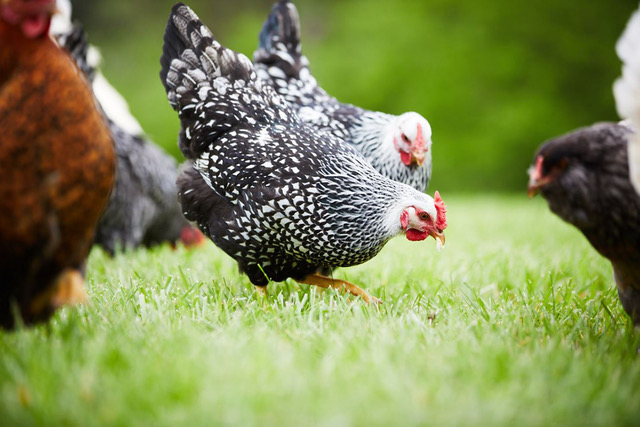
For backyard chickens, the number 18 means the same thing. Eighteen weeks is the age when most egg-laying breeds are considered adults. Most excitingly, it’s the time when many breeds will lay their first egg. At this key milestone, you can start switching your chickens to layer feed.
Patrick Biggs, Ph.D., a flock nutritionist for Purina Animal Nutrition says, “This switch is an essential step in the road to farm fresh eggs because hens require different nutrients to produce eggs as compared to when they are growing.”
To produce an egg each day, hens need high levels of calcium, vitamins, and minerals.
“Hens transfer many of these nutrients directly into their eggs, so the chicken feed ingredients in the layer feed play an essential role in the eggs that hens produce,” explains Biggs.
Consider the following steps when transitioning to a complete chicken layer feed:
[mf_h2 align=”left” transform=”uppercase”]1. Choose a chicken feed formula that matches your goals.[/mf_h2]
Select a complete layer feed before the transition begins. Ideally, the layer feed decision should be made by week 16, so the transition can be planned.
First, look for a complete layer feed that includes Purina’s Oyster Strong® System. This is an exclusive blend of oyster shell, vitamins and minerals included right in the layer feed to ensure hens receive the calcium they need to produce strong, protective eggshells. A complete layer feed should also include the 38 essential nutrients hens require without a need to supplement.
“Purina® Organic layer feed, Purina® Layena® and Purina® Layena® Plus Omega-3 are all options that meet these requirements,” says Biggs. “Our chicken feed recipes start at our 12 backyard coops at the Purina Animal Nutrition Center in Gray Summit, Missouri, and are formulated to provide everything hens need.”
No matter your flock goals, be sure the layer feed is made with simple, wholesome ingredients.
“The layer feed should include: 16 percent protein and at least 3.25 percent calcium as well as key vitamins and minerals,” explains Biggs. “These are just essentials, though. Look for additional ingredients in the layer feed to bring hen health and egg quality to the next level.”
A few next level ingredients to look for include:
- For rich, yellow yolks: Marigold extract
- For strong shells: Oyster Strong® System
- For immune digestive health: Prebiotics and probiotics
- For vibrant feathering: Essential amino acids such as lysine and methionine
- For omega-rich eggs: Added omega-3 fatty acids
[mf_h2 align=”left” transform=”uppercase”]2. Transition over one week.[/mf_h2]
When birds reach 18 weeks old or when the first egg arrives, slowly switch your chickens to an organic layer feed. It is important to make the transition over time to prevent digestive upset.
“For our hens on our farm in Missouri, we have found it’s best to make the transition over time rather than all at once,” explains Biggs. “We mix the starter and layer feed evenly for four or five days. If birds are used to crumbles, start with a crumble layer feed. The same goes with pellets. The more similar the two feeds are, the more smoothly the transition will go.”
Many hens will eat the mixed feed without noticing a difference. When hens are eating both feeds, you can stop feeding the starter feed and make the complete switch to all layer feed. It is important to give your birds enough time to adjust to the new diet. Most birds will adjust within a couple of weeks.
[mf_h2 align=”left” transform=”uppercase”]3. Keep it consistent.[/mf_h2]
Once the transition to layer feed is complete, it’s best to maintain a routine.
“We recommend providing free choice complete layer feed to hens and switching out the feed each morning and evening,” says Biggs. “If birds are free-ranging, offer the complete feed to hens before they go out in the morning. This will help them consume the nutrients they require before filling up on less nutritious insects and plants.”
It’s important for the complete feed to make up at least 90 percent of the hen’s diet.
“We feed complete layer feeds on our farm because they are formulated to provide all the nutrients hens require at the correct levels,” explains Biggs. “It’s reassuring to know that each bite of feed is balanced to keep our hens healthy and producing quality eggs.”
To receive a coupon to try one of Purina’s complete layer feeds with their Oyster Strong® System, sign-up for Purina’s Feed Greatness® Challenge.
To learn more about raising backyard chickens, go to www.purinamills.com/chicken-feed or connect with Purina Poultry on Facebook or Pinterest.
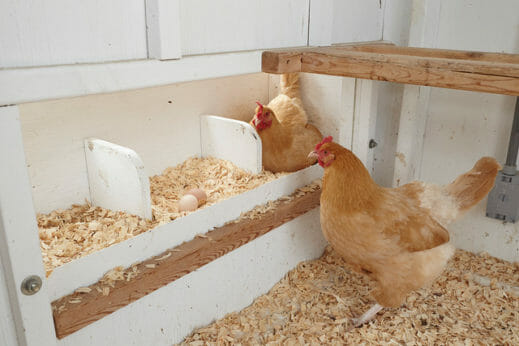
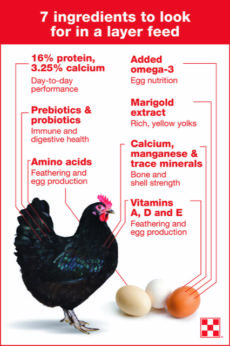
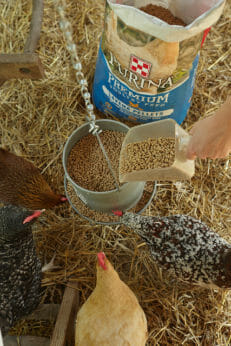
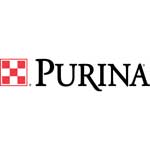
This is what I need, the very beneficial chicken breeding experience that you share helps me develop my chickens, thank you very much.
Can rosters eat later feed I have a few rosters mixed with my hens